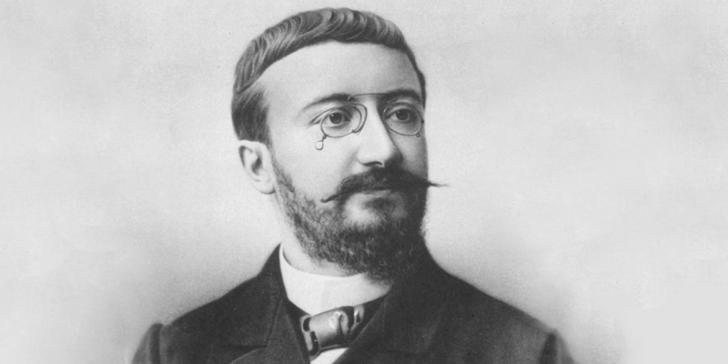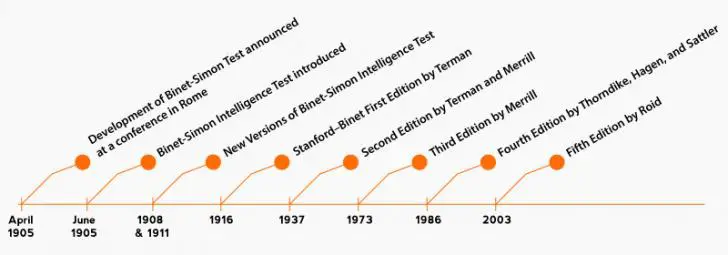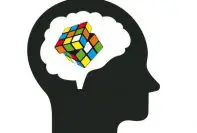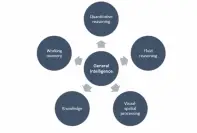Sir Francis Galton was the first man to attempt to measure intelligence. He conducted a battery of tests which measured such characteristics such as head size, visual acuity, breathing capacity, strength of hand grip, reaction time and memory for visual forms. The pioneer Englishman believed that simple sensory, perceptual and motor responses were the key aspects of intelligence.
The term mental test was first coined by J.H. Catell. The works of Catell and Galton together enhanced the further studies on intelligence.
History of Stanford – Binet Intelligence Scale

First ever systematic attempt to develop a test of intelligence was made by Alfred Binet, a Frenchman, at request of the French Ministry of Education in 1904. He was asked to measure objective intelligence of school children and categorize them into different classes in terms of mental development.
Later, the Binet-Simon Intelligence Scale developed by Binet and Theodore Simon was administered to children to evaluate their performance (mental age) at a given chronological age. IQ (Intelligent Quotient) was used to evaluate a child’s learning by potential.
In 1916, Lewis M. Terman, from Standard University, published a refined version of the test and named it Stanford-Binet Intelligence Scale. The test is still used today, with intelligence level being measured in IQ. The test allows comparison of children of different ages. The test was revised in 1937, 1960 and 1986.
Binet – Simon Test and Stanford – Binet Test
It is known as the first intelligence test published in L’Année Psychologique. In this essay, three different methods were input to study “inferior states of intelligence.”
- Pedagogical method (judgment of intelligence based on acquired knowledge)
- Psychological method (measurement of intelligence and direct observation)
- Medical method (pathological, physiological and anatomical signs of inferior intelligence)
Psychological method was regarded the most direct method because it measured the intelligence of a person based on their current capacity to
- judge
- reason
- comprehend
- invent
Binet – Simon Test in French schools between 1905-1908 dealt with attention span, memory and verbal skill of the children. The test was comprised of 30 items that covered the ability to touch one’s nose or ear when asked, to the ability of drawing designs from memory. Other tasks included defining abstract concepts, and each task varied in difficulty as it progressed. The idea that a child’s intellectual ability increases with age was proposed by Binet.
The Stanford – Binet Intelligence Scale consists of four cognitive area scores.
- Verbal Reasoning
- Visual/Abstract Reasoning
- Quantitative Reasoning
- Short-Term Memory
Scoring of these four cognitive areas together determine the factor score and composite scores. The standard time taken for the test to be completed is 45 to 90 minutes. But, it can also take as much as two hours and thirty minutes.
The composite score is considered to be an estimate of general reasoning ability or “g”. It is regarded as a global estimate of a person’s intellectual functioning.
Binet’s intelligence scale was divided into categories based on IQ score. Although there have been few changes regarding the original names used to categorize a person based on their IQ level. Terms like moron, imbecile, and idiot, among others are no longer used. Below is the Binet Scale of Human Intelligence.
| IQ Score | Original Name | Modern Term |
| Over 140 | Genius or Near Genius | |
| 120-139 | Very Superior | |
| 110-119 | Superior | |
| 90-109 | Average or Normal | |
| 80-89 | Dull | Dull normal |
| 70-79 | Borderline Deficiency | Mild |
| 50-69 | Moron | Moderate |
| 20-49 | Imbecile | Severe |
| Below 20 | Idiot | Profound |
The current edition of Stanford – Binet Test was published in 2003, having first been developed in 1916 and revised in 1937, 1960 and 1986.

Other Intelligence Tests throughout the History
David Wechsler came up with another intelligence test in 1930. He created items measuring performance in verbal as well as non-verbal tasks. His first scale was designated for adults, and later on in the year 1956, he created a separate test for children called Wechsler Intelligence Test for Children (WISC). Revised version of the test was formulated called WISC-R. And tests for pre-school children were called WPPSI.
In course of mental testing movement, Psychologists soon began to realize that in most situations, group tests of intelligence are desirable or absolutely essential. Two forms of tests were created in World War I, Army Alfa Test (AAT) and Army Beta Test (ABT). AAT was designed for measuring the intelligence test of soldiers (illiterates) who were not well conversant in English language.
More drastic version of the AAT and ABT was created around the World War II, called Army General Classification Test (AGCT). It consisted of 4 subjects.
- Verbal ability
- Spatial comprehension
- Arithmetic computation
- Arithmetic reasoning
AGCT’s scoring was done in the similar manner to Stanford – Binet test (SBT). Average Score is kept 100 of SD 20.
Similar classification test was also developed by psychologists working in the naval wing. The test is known as Naval General Classification Test (NGCT). The test is used to measure intelligence of new recruits, where the average score is 50.
There are various types of tests designed for young children and illiterate who are poor in using language intelligence. Most popular tests in the category are
Form Board Test (FBT)
The test consists of different sizes of form and 10 blocks corresponding to the definite size formed in the board. Subjects are required to fit the block in the correct size of board. The test is useful for young children, mentally retarded children and those who are mentally ill.
Picture Complete Test (PCT)
In this test, subjects are required to complete the incomplete pictures selecting out the given several figures of missing parts. Raven’s Progress Matrices (RPM) is one of the examples of the test. Scoring is done on the basis of time taken and errors made.
Alexander’s Performance Battery (APB)
The battery consists of three tests.
- Pass along test of Alexander
- Block design test of Koh
- Cube Construction Test of Gav
Each test is further divided into sub tests. Total IQ is determined on the basis of scores obtained on the whole battery.
Intelligence tests are generally taken as the influencing factor in a person’s life. A person with higher intelligence is predicted to have higher grades and better jobs. But, it’s not 100% guaranteed. Because there are so many different Types of Intelligence, IQ level of a person cannot be regarded as the deciding factor in his life.



